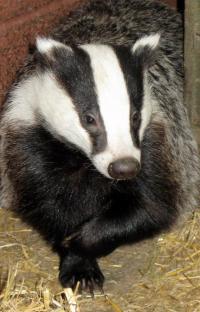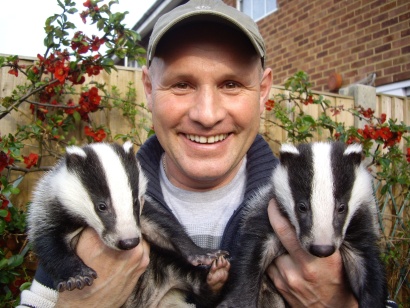You are here
About The Badger
| Common Name: | European (Eurasian) Badger |
|
| Scientific Name: | Meles meles. Members of family known as Mustelidae (means: possessing musk glands). This family includes weasels, otters, stoats, pine marten, ferrets and polecats. |
|
| Gender Names: | Boar (male), Sow (female), Cub (infant). | |
| Life Span: | 5 - 7 years (typical in wild). Have been known to live up to 13 years. |
|
| Body Length: | 75cm (30") head to tail. 90cm (35") max. |
|
| Weight: | 10 - 12kg (22 - 26lbs) average. 23 - 27kg (51 - 60lbs) heaviest recorded. |
|
| Distribution: |
Found throughout Europe with sub-species present in all continents except the Arctic and Antartic. Particularly abundant in Britain and Ireland with the majoritory found in southern England. |
Description
Badgers are stocky, short legged animals which are easily recognisable by the black and white stripes which run from their nose to shoulders. They have small heads and eyes with a thick short neck and long wedge-shaped body that ends with a short tail.
Their powerful short legs end with paws each having five digits which are tipped with long, thick, sharp claws. This makes them very efficient diggers.
The badgers body is covered in black and white hair which gives them a grey looking appearance from a distance. They have a black chest and legs, a highly distinguishable black and white striped head with black ears that are tipped with white. Some badgers have different colour variations such as ginger (erythristic) instead of black (melanistic). Also some can be white (albino).
It can be difficult to tell male from female badgers. Generally males are slightly larger and heavier than females and normally have a wider head and a longer, thinner and lighter coloured tail.
Diet
Badgers are ominivores. Their diet consists of mainly earthworms and grubs but can also include frogs, small mammals, birds, eggs, lizards, insects, plant bulbs, seeds and berries.
Behaviour
Badgers are a nocturnal animals that spend most of their lives underground in burrows called setts. They have a highly social behaviour and live in family groups of up to 12 individuals. These groups display signs of hierarchy with a dominant boar and sow leading the group.
Around dusk they usually tend to leave their setts to forage for food all through the night until dawn when they return back to the safety of their sett.
Habitat
Badgers can live in a large range of habitats. They are found mainly around the edges of woodlands and pastures, but can also be found in scrublands, under hedgerows, in old quarries, on moorlands and open fields. Sometimes they can even be found living in gardens on housing estates.
The habitat chosen by the badger has to be somewhere where food can be plentiful throughout the year. The site also has to be secluded and well covered to allow inconspicuous emergence from setts. It also needs to be free from disturbance.
Interesting Facts
- The remains of badgers have been found in Britain which date back some 250,000 years.
- Badgers are one of the fastest digging animals on the planet.
- A badger sett can be hundreds of years old.
- An adult badger can consume up to 200 earthworms in one day.
- Badgers mate at any time throughout the year but, due to a process known as delayed implantation, the cubs are born between January and March.
Contact Us:
-
Tel: 07341 944567
or
07341 944568
-
eMail: info@ebpg.co.uk
The Essex Badger Protection Group
is affiliated to The Badger Trust

Registered charity No. 1111440
Website by Souris Systems

 Picture courtesy Frank Last
Picture courtesy Frank Last